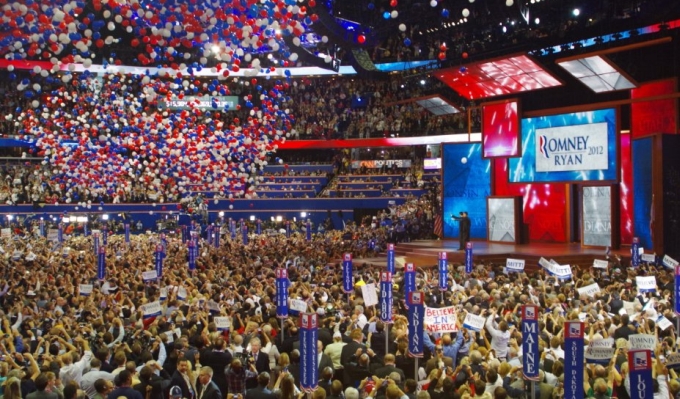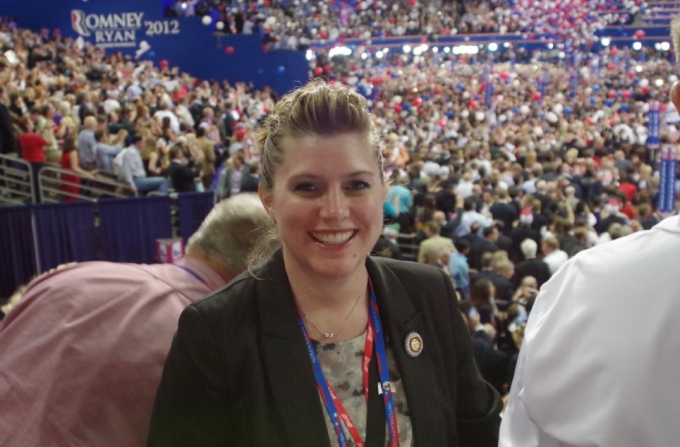Glitter Bombings and Hurricanes. An Inside Look at Political Event Planning.
- Posted in:
- Interviews

The 2012 Republican National Convention
Televised debates, political rallies, straw polls, town hall meetings, $10,000 a plate fundraisers, and national conventions can be a logistical nightmare. It takes real skill, focus and years of experience to successfully plan for all contingencies and organize all the details.
With the presidential elections just around the corner, we decided to investigate just what goes into a political event, what makes them so challenging, and what it takes to successfully pull one off.
We reached out through our network here at eVenues and got in touch with Julie Ann Schmidt, meeting planner and managing partner at Lithium Logistics. In addition to many state and city level political events, Julie Ann has done work for the 2008 Republican National Convention in Minneapolis, the 2011 Iowa Straw Poll, as well as managing logistics for the South Dakota Delegation to the 2012 Republican National Convention in Tampa, Florida.

Julie Ann Schmidt, CMP, CMM
We chatted over the phone and Julie Ann was kind enough to share with us her considerable knowledge of political events. We talked about how she got involved with political events, and discussed just what makes political events different from “regular” events. Finally, Julie Ann also shared some war stories about hurricanes and attempted glitter bombings–more about those below.
Getting Involved in Political Events
While Julie Ann had experience in politics in Wayzata, a smaller city in Minnesota, the job was largely apolitical. Because she wanted to get involved in more politically oriented events, however, she eventually passed up on a promotion and started pitching her services to officials within the party she affiliated herself with.
She told them: “I can door knock. I can work the phone bank just like anyone else, but I can be of more value to you if I’m helping you save money on your events, reduce the risk on your events [and] plan more logistically tight events…Let me bring you the skill set I have because you don’t have that resource as in-depth on your team.”
And that’s how it all started. through her local government connections and by promoting her services as a planner, Julie Ann was given an opportunity in 2008 to work for the RNC in the capacity of the committee on arrangements (COA). The COA is the company that gets formed to execute the RNC every four years. For Democrats it’s the Democratic National Convention Committee (DNCC). These entities get formed in the city where where a convention is to take place. They hire staff, they employ them, they run the business, then after the convention happens, they close the business.
For Julie, Ann working for the COA was a “Phenomenal opportunity. I knew at the time it was once in a lifetime and I look back and it was THE once in a lifetime [opportunity]…When you work on something that big it’s it’s a big, very big event. I really think the only thing bigger is an Olympics. But yet it’s not as big as an Olympics so that you can still understand the whole event and get to know every part of it,” says Julie Ann.
Political Events: It’s all about connections
As far as doing work for political events, one opportunity has lead to the next. “You work on something, you meet somebody, and all of a sudden there’s another opportunity,” says Julie. Ann
All of Julie Ann’s political business has been referral. She gave one example of how she did some work for the Republican Party of Minnesota’s State Conventions. It just so happened that one of the people she worked with on a State convention became the executive director for South Dakota. Through that connection she was later hired to do their conventions as well.
What Makes Political Events Different?
Political events are a special breed, and while many elements of planning a political event are the same as they are for regular events, there are a few differences. The main areas where differences can be seen are with security, press, the agendas and flow of the events, and it goes without saying, the politics.
Security
Political event planners will often look at security in a different way. For a State Convention the main floor space is just for voting delegates or alternates, so the space needs to be controlled This requires security to control a few access points and it helps keep people who are not credentialed off the floor.
Votes are oftentimes voice votes. If a vote count is needed, people will be asked to stand up and have their vote counted manually. State conventions want to ensure that only the elected delegates or their alternates get to vote, so they’ll often have their own security people doing things in addition to what you think of as traditional security tasks.
Glitter bombing, or the act of dumping glitter on a candidate or political figure as a form of protest, can also be a concern. In fact, during the midwest leadership conference in 2011 that Julie Ann planned, they had had a number of high level speakers and an awareness of potential glitter bombers and they even had pictures of who those people were.
At this particular event, they had someone try to glitter Karl Rove. Since security was on the alert for them, they knew kind of what signs to look for. The glitter bomber approached Karl with a Triscuit box full of glitter but because they were watching, they were able to stop him, knock the box of glitter down, and none of it got on Karl Rove.
After the attempted glittering, they were able to then contain the person and ask Karl, the client putting on the event, and the venue if they wanted to press charges, which, says Julie “is something you’d never do at a corporate event.” The outcome of that was that Karl and the client didn’t press charges but the venue did press trespassing charges because the glitterer had hit somebody else at their building before, “Because,” explains Julie, ”from their point of view as a venue, he’s being dangerous and disruptive [and] could make clients not want to come.”
The Press
The press is another element for meeting planners to be aware of. “Rarely do you have press show up at a corporate annual meeting and you certainly don’t have press risers and mult boxes at the back for multiple cameras or a sectioned-off area of the floor for press,” says Julie Ann.
If you’re doing a convention or similar event you’ll be giving space on the floor to press and that’s something you’ll have to plan for. If you’re doing something in a more open area like the Iowa Straw Poll, however, you’re not controlling a space for press, but they’ll be present at the event. They might be coming to your space and interviewing people and things like that, and that’s something to be aware of.
Agendas and Flow
Corporate events follow a pretty much set pattern. There’s a general session, breakouts, another general session and then meals afterwards. For the most part the audience is there to learn and hear material, not to discuss any issues or make a proposal. With the exception of Q&A, it’s pretty much one sided.
Political events, on the other hand, can be quite different. “With state conventions, more so than national conventions,” says Julie Ann, “[there is] a little more of a give and take with the audience and the presenters, so agendas can be different and have a different style and flow…You’re having reports on rules and dialogue from the floor [and] proposals” This give-and-take aspect can make the agendas very different than a regular event.
The Politics (Of Course)
Another thing for planners to watch out for that Julie Ann mentioned is that individual personalities tend to be a bit stronger in a political environment than what you might encounter in a more toned down corporate or association environment. While there may be some politics involved in planning a corporate or association event, rarely do you have three candidates who are running for the same spot staying in the same hotel. The question of course arises as to who gets which suite and how to make everything seem fair.
The 2012 RNC: A “Perfect Storm” of Challenges

Hurricane Isaac Approaching Tampa before the 2012 RNC
As you may know, being an event planner is all about planning for contingencies and putting out fires, and with events the size of a national convention, the scale of these fires can increase to epic proportions.
The 2012 Tampa RNC was no exception. There was a lot of reworking of the agenda due to the potential of Hurricane Isaac coming to town. “That was a real challenge,” says Julie Ann, “cancelling buses, moving bus times, and everyone’s doing it…the bus company’s getting 40 phone calls from people…different state delegations that need to move their buses.”
Because of the bus problem Julie Ann and her team also had to rework a lot of the details in the agenda they had prepared for their delegation. “All the plans we had kind of went out the window,” says Julie Ann, “and you’re just reacting to things as they happen…It was challenging but everything really worked out and given me and my team’s experience, we were able to really give our clients the best and advice and make the best changes…and react to the different changes that were happening day to day.”
Who Really Makes it Happen?
In the coming weeks when you watch the televised presidential debates and other poltical events, take a moment to think about all the work that went behind the scenes. What did it take to bring all those people together? Where did those thousands of red, white, and blue balloons come from? Who sold them? Who ordered them? Who put the security in place? Who prepared for the press? Who organized hotel rooms and meals for the thousands of people attending? Behind the fanfare and spectacle, there are hundreds and hundreds of phone calls being made, RFPs being submitted, contracts being signed, rooms being reserved, and tickets being bought. It’s the meeting planner who makes all that happen. Take a moment to think about that.
Comments